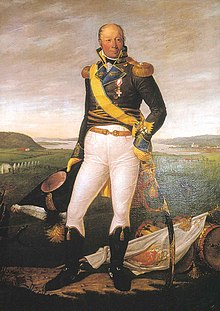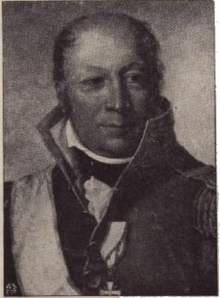Diderich Hegermann
Diderich Hegermann (born December 6, 1763 in Altona ; † February 7, 1835 in Kristiansand ) was an officer in the Norwegian armed forces during the Norwegian-Swedish War of 1814. He expanded the war school in Christiania and was a member of the Imperial Assembly in Eidsvoll in 1814 and later became a State Councilor.
He came from an old line of officers. His parents were Lieutenant Colonel and Land War Commissioner Cay Detelef Hegermann (1732-1800) and his wife Anna Esther Stuhlmann († 1778). On December 2, 1815, he married Hanne Susanne Christine Isaachsen née Nideros (1779–1858), widow of the consul Daniel Isaachsen (1744–1813) and daughter of the mayor Otte Nideros (1734–1809) and his wife Marichen Arctander (1748–1817) .
Military career
In keeping with family tradition, he too embarked on an officer career. In 1776 he became a cadet , served as a non-commissioned officer until 1786 and then became a lieutenant in the cadet corps in Copenhagen . In 1790 he became a captain and was transferred to "Den frie mathematiske Skole", which later became the war school. He saw his most important task in the training of officers. He taught himself and later became the head of officer training in Norway. He wrote the story of "Den frie mathematiske Skole" and his main aim was to equate this school with the Land Cadet Corps in Copenhagen. In 1798 the school was renamed "Det norske militaire Institut". In 1800 he became a major and head of this school. In 1804 it became "Det Kongelige Norske Land Cadet Corps". In 1808 he became a lieutenant colonel and took part in the war against Sweden on the Norwegian-Swedish border in the winter of 1808/1809. In 1812 he became the commander of the Opland infantry regiment. In 1814 he commanded "Det Kongelige Norske Land Cadet Corps" and was involved in several battles with the Swedes in the summer of 1814 during the Swedish-Norwegian War . He won an important victory against the Swedes in the battle of Langnes-Schanze . In the autumn after the capitulation and the peace of Moss , he supervised the observance of the armistice at the Swedish headquarters in Fredrikshald . In November 1814 he was appointed major general. The next day he became a councilor of state for the army and the navy, an office that did not suit him. Therefore, in 1815, he submitted his departure, which the king refused. The following year he obtained a leave of absence for a year, and in 1817 the king reluctantly gave him his farewell. He had no contact with the royal family and did not take part in the celebrations on the occasion of Crown Prince Oscar's visit in 1833.
Political activity
Hegermann was one of the first to be informed in the spring of the plan that Norway should become an independent state after the Peace of Kiel . He was a member of the Reich Assembly of Eidsvoll for his regiment. Although he was a supporter of the self-employment plan, his independence meant that he also had friends in the opposing camp. He was a member of the Constitutional Committee and was even president of the congregation the second week of its session.
Two provisions of the Norwegian Basic Law can be traced back to him: the provision that amendments to the constitution must not contravene the constitutional principle and general military service. He saw compulsory military service as a school for the nation. He also became a member of the conscription committee and a committee that should determine the state of the country. From an early age he strived that everyone who wanted to become an officer in Norway had to go through the officers' school he ran. This was to prevent officer patents from being awarded on the basis of wealth, status or relationships. This principle was then adopted in 1815.
Through his wife, the widow of the consul Isaachsen in Kristiansand, he became the owner of land in Tveit . Here he ran a sawmill, a mill and a shipyard. So he was able to export wood on his own ships. He survived the upheavals after 1814 economically well. Typhus broke out in Kristiania in 1835 . His eldest daughter fell victim to him, and a few days later he himself, while his wife survived.
Hegermann was a knight of the Dannebrog Order .
literature
- Terje Bratberg: Article “Diderich Hegermann” in: Norsk biografisk leksikon , accessed on November 30, 2011.
Web links
| personal data | |
|---|---|
| SURNAME | Hegermann, Diderich |
| ALTERNATIVE NAMES | Hegermann, Didrik |
| BRIEF DESCRIPTION | Officer in the Norwegian Army, Minister of War |
| DATE OF BIRTH | December 6, 1763 |
| PLACE OF BIRTH | Altona |
| DATE OF DEATH | February 7, 1835 |
| Place of death | Kristiansand |

